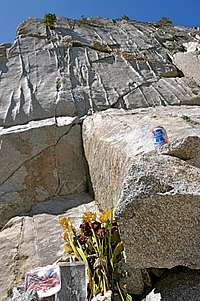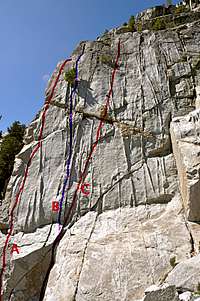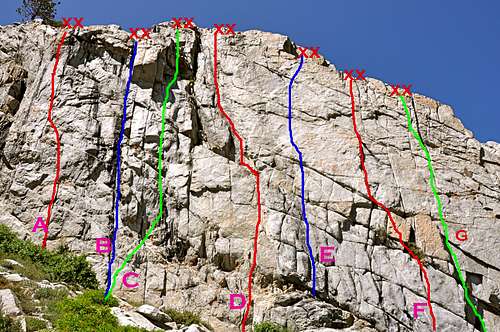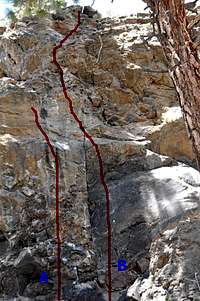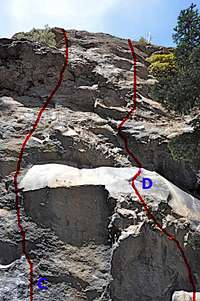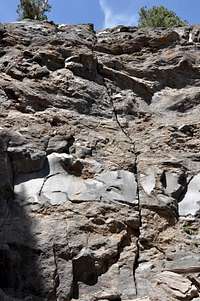-
 15328 Hits
15328 Hits
-
 92.32% Score
92.32% Score
-
 38 Votes
38 Votes
|
|
Area/Range |
|---|---|
|
|
37.59650°N / 119.0122°W |
|
|
Trad Climbing, Sport Climbing, Toprope |
|
|
Spring, Summer, Fall |
|
|
8000 ft / 2438 m |
|
|
Overview
When we speak about the town of Mammoth Lakes and Mammoth Mountain, the first thing that comes to our minds is skiing. Mammoth Mountain is, in fact, a dormant/semi-active volcano and for decades it has been the destination of choice for southern California skiers. During the summer months, Mammoth Lakes turns into one of the most desirable resorts for mountain biking, fishing, hiking and rock climbing. The town itself is at an elevation of 7500 feet and the nearby lakes and mountains stay pleasant during the hot summer season. Forget trying to get up before dawn to get a couple of hours of climbing around Owens Valley before temperatures soar to over 100 degrees. Go to Mammoth Lakes and climb on many small to large rock formations at elevations exceeding 8000 feet.
| Note: There are countless rock formations in and around Mammoth Lakes. Some of these formations are developed and some remain for future development. This page by no means includes all of them. The purpose of this page is to provide a medium in which future information may be placed. |
Dike Wall, North Face
Dike Wall, North FaceEven though Mammoth Mountain is a volcano, many of the rock formations in its vicinity are granite. One may argue that granite is also vocanic, although it is of a different chemistry that makes it by far more solid. The history of climbing on Dike Wall dates back to the 1980s when most of the routes were top-roped. During the 1990s and early 2000s many of the old routes were bolted into sport climbs. The access to the top for the left side of the north face is achieved via a fun 5.8 crack named “Mr. DNA.” Mr. DNA is a gear-protected hand crack with a small tree growing out of it near the top. You can easily set up top rope for a 10a face to the right of the crack, or a 10b shoulder to its left. The right hand face, Mr. Kamikaze, 10a, and the left shoulder, Mongoloid, 10b, are both bolted now and can be done on lead or top rope.
The sport routes of the right side, or true north face, of Dike Wall are not as moderate as the far left ones. Except for one 10c route called “Double Ender,” the rest are all in the 5.11 to 5.12 range. There is a crack/corner on the far right side of the north face called “Solo route, 5.7” that provides access to the top. I have not been fortunate enough to see anyone leading any of the harder routes on the north face. Most of the routes of the north face have their own anchors that can be used for lowering off.
A personal note:
John Bachar’s reputation proceeded him wherever he went. The first time I saw him was at Owens Gorge where he quickly soloed “Hard Copy, 12a”, a climb that I top-roped with a great deal of difficulty and “Hangdogging.” Peter Croft, another legendary climber, who accompanied John Bachar on the first two grade six walls in Yosemite in one day, gave a slide show in Santa Barbara. Someone in the audience asked Peter how they were able to pass so many climbers on two big walls. Peter answered, “If John was in front, everybody cleared the way for us, and if I was in front all I had to tell them was that ‘John Bachar is coming up.’”
John Bachar was a legend and an icon. The climbing community will miss him for a long time.
Dike Wall, north face | |
| A | Mongoloid, 10b, bolts |
| B | Mr. DNA, 5.8, crack, standard rack, bolt anchor |
| C | Mr. Kamikaze, 10a, it has been bolted into a sport route |
| D | Quick Lick, 11a, bolts |
| E | Dichotomy, 11b, bolts |
| F | Strap-On-Tools, 12a, bolts |
| G | Black Leather, 11a, bolts |
| H | Box Lunch, 11d, bolts |
Dike Wall, East Face
Dike Wall, East FaceIt is not clear why Dike Wall was not explored for climbing potential until the late 1990s. I have no doubt a crack climb, called “Mr. D.N.A” rated 5.8 on the north face was climbed long before the whole formation was developed into a sport climbing area. Considering the elevation of 9400 feet, the amount of snow fall in the Mammoth Lakes area must shortened the climbing season to a great degree. In any event, what’s abundantly clear now is that the east face of Dike wall has become the more popular of the two climbable faces.
The east face of Dike Wall is steep, in fact slightly overhanging, and well featured. Except for one climb that requires gear placement, “Black Dihedral” rated 10b, all the rest of the routes are bolted sport climbs. All the routes have their own three point anchors of the safest and highest quality. Considering the steep nature of Dike Wall’s east face, it’s only natural that several of the routes have a higher level of difficulty. There are, however, three climbs in the 5.10 difficulty range to keep more moderate level climbers busy for several hours. If you are trying to escape the heat of lower altitude rocks, hike up to Dike Wall and climb on its east face.
Dike Wall, East Face | |
| A | Black Lassie, 10d, bolts |
| B | Black Dihedral, 10b Standard Rack, pro to 3.5" |
| C | Grinder, 11c, bolts |
| D | Grim Reality, 10b, bolts |
| E | Secret Agent Man, 12a, bolts |
| F | Antibro, 11b, bolts |
| G | Cromagnon, 10a, bolts |
Warming Wall
Warming WallIf you are visiting the Warming Wall from the lowlands, such as the coast of California, don’t be surprised to get a little winded making the approach to or climbing on this formation. Warming Wall is at an elevation of 8300 feet and it will give you a workout even on a 5.9.
On my first visit to Warming Wall in the mid to late 1980’s there were fewer than two bolted routes on it. Most people just top roped the wall. In the late 80’s and early 90’s more and more bolted routes appeared. In contrast to the 80’s and 90’s, on my last visit to warming Wall in July of 2009, I saw so many new routes I wasn’t sure how to distinguish the new ones from the old. In some cases the routes seem to be only six or seven feet apart. For the sake of accuracy I will do my best to identify the routes on my diagram, but I’m not going to put my money on the exactness. Use your own judgement when you get to the crag.
Warming Wall is about eighty feet tall and can easily be set up for top roping. You can approach the top from the right. There are many three-piece anchors just below the top for lowering off if you are leading the climbs. The anchors vary in type from old cold shuts to new bolts and chains, or a combination of both.
Warming Wall actually consists of two formations separated by a wide crack/chimney. The smaller right hand formation has one of my favorite climbs called Greenhouse Effect, rated 10c. I have noticed three more bolted routes to the right of Greenhouse Effect. Unfortunately, I have not been able to get any information on these three newer climbs.
Climbs of Warming Wall | |
| A | El Nino, 11a, 4 bolts |
| B | Nuclear Winter, 11b, 6 bolts |
| C | Jam It, 11b, 7 bolts |
| D | Heat Vampire, 11a, 8 bolts |
| E | One Eyed Jack, unknown rating, bolts |
| F | Oh Zone, 10b, 9 bolts |
| G | Warming Trend, 10a, 5 bolts |
| H | Warming Wall Crack, 5.8, Standard rack, pro to 5 inches |
| I | Unknown name, unknown rating, bolt protected |
| J | Faulty Brake, 10a, 7 bolts |
| K | Ghetto Blaster, 10b, 5 bolts |
| L | Hot Flash, 10a, 6 bolts |
| M | Greenhouse Effect, 10c, 6 bolts, This climb is located on the smaller formation to the right of the main wall. There are also three more new climbs to the right of Greenhouse Effect. Sorry, no information on those |
Horseshoe Slabs
Horseshoe SlabsFor many years Horseshoe Slabs have been an area where you bring your family or friends to top rope climbs. During the past several years, however, several of the routes were bolts into sport routes, and some even have names. The days of designating only numbers to the routes are slowly disappearing. I have also noticed that a number of climbs on the left formation have bolted anchors. I feel that this new development has made Horseshoe Slabs a safer rock to play on. The old trees that were used for anchors were either dead or about to die. To set up anchors on the left formation, which is the steeper and more difficult of the two, you need to take several long slings to help get close to the edge to use the bolt anchors. Put yourself on belay and be safe.
The right formation is much lower angle than the left one thus contains easier climbs. The left crack on the right slab is called “Rodeo Rider” rated at 5.6, and it’s a great beginner route. This climb can be done on lead with a standard rack and even has its own bolted anchor.
It is possible that, in time, all the routes on the two Horseshoe Slabs will get their own three point bolted anchors; however, at the present time most climbers use the trees on top as anchors. The approach to the top is done via the right side.
Climbs of Horseshoe Slabs | |
| A | Top Rope, 5.8 |
| B | Top rope, 5.7, follow the left wide black streak |
| C | Wrangler, 5.8, bolts and gear, standard Rack. Follow the right black streak. |
| D | Horseman, 10a, bolts to a good anchor |
| E | Slab, 5.9, top rope to a good anchor. Many possible variations. |
| F | Top rope a slab, 5.7 |
| G | Cow Puncher, 5.6, left prominent crack, standard rack |
| H | top rope a slab, 5.7 |
| I | Rodeo Rider, 5.6, right prominent crack, standard rack |
| J | Top Rope, 5.9, slab |
| K | Blacksmith, 5.8, bolt and gear, standard rack |





